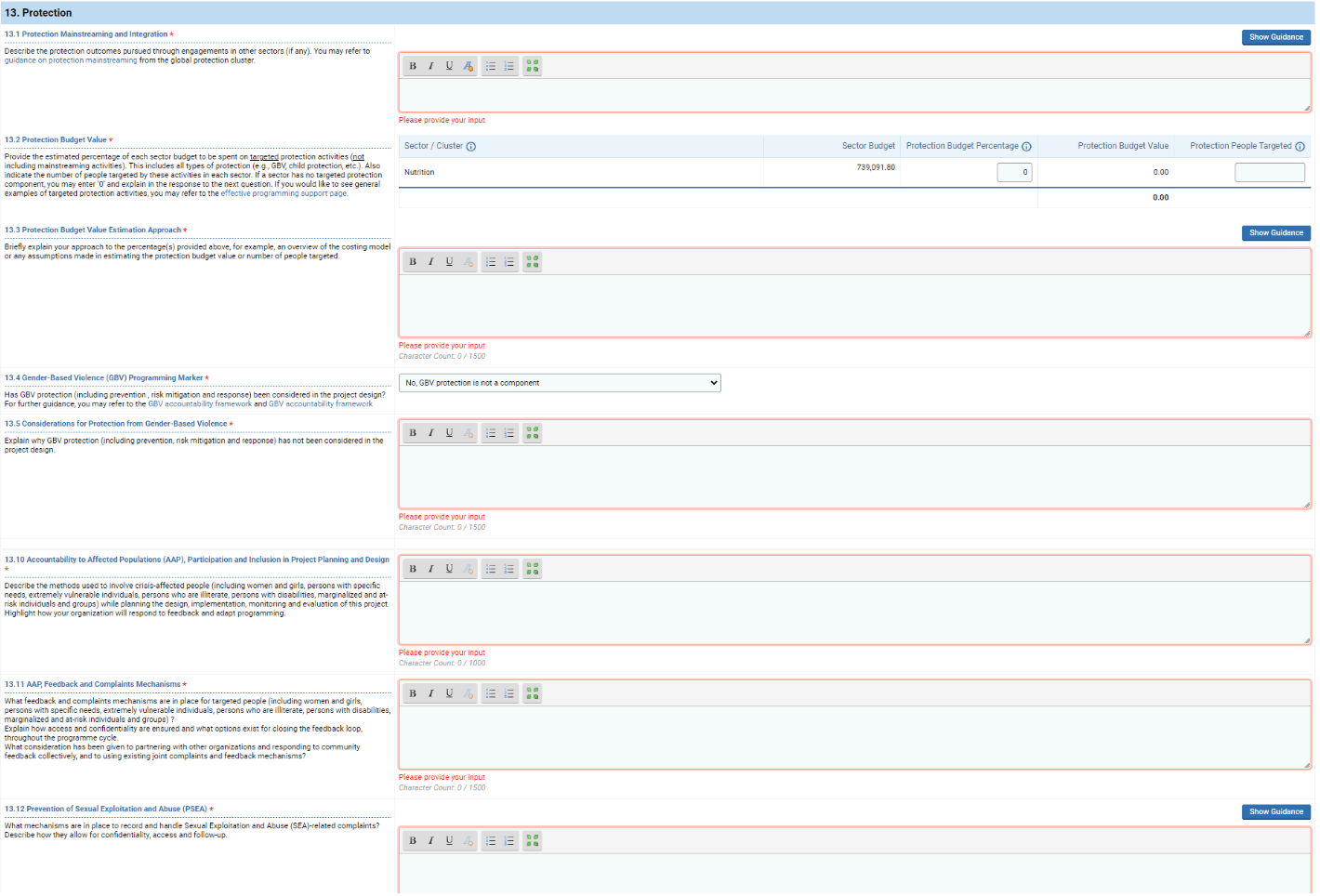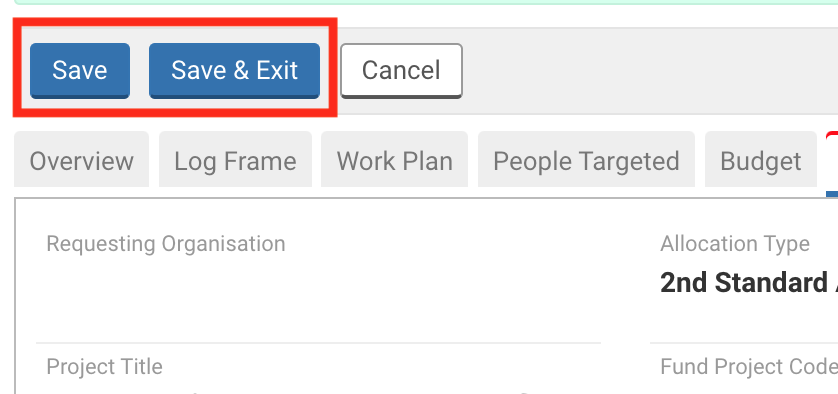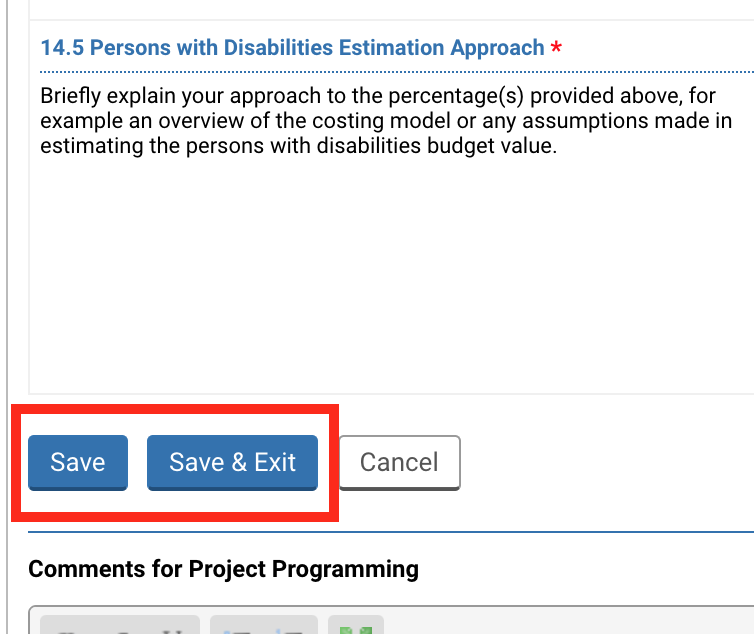General features
12. Localization
13. Protection
14. Gender Equality
15. Persons With Disabilities
This section tracks cross-cutting themes and the effectiveness of humanitarian programming, including all pillars of protection, gender equality and persons with disabilities. All fields marked with an asterisk * are mandatory.
Please note: if the project is a single cluster project and the cluster is ‘Coordination and Common Services’, this tab will be disabled.
Please note that all the data provided in the screenshots of this article is purely indicative.

- When available, you can click on [Show Guidance] to show or hide additional guidance.

- You can edit the font of your text using these tools:

- You can expand or reduce the narrative box by moving the bottom right corner of the box.

- When available, you can hover over the info icon
 to display additional guidance.
to display additional guidance.

12.1 Localization *


13.1 Protection Mainstreaming and Integration *
Protection mainstreaming is an imperative for all humanitarian actors engaged in humanitarian response and ensures a protection lens is incorporated into operations. Protection integration involves achieving protection objectives through the programming of other sector-specific responses (i.e., beyond the protection sector response) to achieve protection outcomes. For further guidance, you may refer to the IASC protection in humanitarian action.

13.2 Protection Budget Value *

Fields description:
- Sector/Cluster: displays all the clusters assigned for the project.
- Sector Budget: displays the budget allocated to each sector/cluster according to the information provided the ‘Budget’ tab.
- Protection Budget Percentage: enter the percentage of funding that will be allocated to protection activities in each sector/cluster. For the protection sector/cluster, the default value is 100%. If there are no protection activities for the sector/cluster, you can enter 0%.
- Protection Budget Value: automatically displays the budget value for each sector based on the ratio provided in the ‘Protection Budget Percentage’ column.
- Protection People Targeted: enter the number of people targeted with the funding requested from OCHA. It should be based on the percentage given in the ‘Protection Budget Percentage’ column and the ‘People Targeted’ tab. If there are no protection activities for the sector/cluster, you can enter 0.
Please note: when the ‘Protection Budget Percentage’ is higher than 0%, the number of people targeted should never be 0. However, the user can enter 0% for the ‘Protection Budget Percentage’ and add a small number of people targeted.
13.3 Protection Budget Value Estimation Approach *
If applicable, you can also provide a brief description of the protection activities or services included in the project, but funded through external funding sources (i.e., excluding grant request).

13.4 Gender-Based Violence (GBV) Programming Marker *
Select an option from the drop-down list.

Fields description:
- Yes, GBV protection is the main objective: all project activities directly pursue GBV protection outcomes.
- Yes, targeted GBV protection programming is a component (but not the main objective): some of the project activities/project components directly pursue GBV protection outcomes.
- Yes, GBV protection is mainstreamed (but no targeted programming): protection from GBV is considered as an operational approach, but no GBV protection outcomes are directly pursued. However, indirect GBV protection outcomes might be obtained from the project.
- No, GBV protection is not a component: protection from GBV is not considered by the project (this mostly refers to Common Services projects – Logistics, Telecoms, UNHAS, etc.).
Please note: if GBV protection is the main objective, please consider adding it as a cluster/sector.
13.5 GBV Considerations * / GBV Explanations *
GBV has been considered in the project: if the response to the previous question was ‘yes’ (of any variance), this question will be displayed, and the user will have to explain how GBV has been considered in the project.

GBV has not been considered in the project: if the answer to the previous question was ‘no’, this question will be displayed, and the user will have to explain why GBV protection has not been considered.

Please note: if you have selected ‘Yes, GBV protection is the main objective’, or ‘Yes, targeted GBV protection programming is a component (but not the main objective)’ the two following questions will be displayed. Otherwise, please click here.
13.6 Gender-Based Violence Budget Value *

Please note: GBV budget values entered in this section should also be included in the overall protection budget value provided in the previous question 12.2 Protection Budget Value.
Fields description:
- Sector/Cluster: displays all the clusters assigned for the project.
- Sector Budget: displays the budget allocated to each sector/cluster according to the information provided in the ‘Budget’ tab.
- GBV Budget Percentage: enter the percentage of funding that will be allocated to protection from GBV activities for each sector/cluster. For the GBV sector/cluster, the default value is 100%. GBV Budget Value: automatically displays the budget value for each sector/cluster based on the ratio provided in the ‘GBV Budget Percentage’ column.
Please note: the GBV Budget Value should also be included in the overall protection budget value provided in the question 12.2. - GBV People Targeted: enter the number of people targeted with the funding requested from OCHA. If there is a protection sector/cluster, the number of people targeted will automatically be displayed according to the data provided in the ‘People Targeted’ tab.
13.7 Gender-Based Violence Budget Value Estimation Approach *
If applicable, also provide a brief description of the protection activities or services included in the project, but funded through external funding sources (i.e., excluding this grant request).

13.10 Accountability to Affected Populations (AAP), Participation and Inclusion in Project Planning and Design *

13.11 AAP, Feedback and Complaints Mechanisms *

13.12 Prevention of Sexual Exploitation and Abuse (PSEA) *
You can find additional guidance in the UN protocol on provision of assistance to victims of PSEA.


14.1 Gender and Age Marker (GAM) *
Once you have completed the questionnaire on the IASC Gender with Age Marker website, select the GAM code received from the drop-down list and enter the GAM Reference.
Please note: the GAM is not mandatory until the project reaches the technical review status. At that point, if no GAM is entered, the budget cannot be cleared by the CBPF finance.

Please note: If the GAM Code is 0, please click here.
If the GAM Code and Reference are not yet known, please tick the box ‘GAM reference not yet available’.

14.2 Gender Equality Programme Focus *
Select an option from the drop-down list.

Fields description:
- Yes, Gender Equality is the main objective: all project activities directly pursue Gender Equality outcomes.
- Yes, targeted Gender Equality programming is a component (but not the main objective): some of the project activities/project components directly pursue Gender Equality outcomes.
- Yes, Gender Equality is mainstreamed (but no targeted programming): gender Equality is considered as an operational approach, but no Gender Equality outcomes are directly pursued. However, indirect Gender Equality outcomes might be obtained from the project.
- No, Gender Equality is not a component: gender Equality is not considered by the project (this mostly refers to Common Services projects – Logistics, Telecoms, UNHAS, etc.).
14.3 Considerations for Gender Equality *
Gender Equality has been considered in the project: if the response to the previous question was ‘yes’ (of any variance), this question will be displayed, and the user will have to explain how gender equality has been considered in the project.

Gender Equality has not been considered in the project: if the answer to the previous question was ‘no’, this question will be displayed, and the user will have to explain why gender equality has not been considered.

Please note: if you have selected ‘Yes, Gender Equality is mainstreamed (but no targeted programming)’, or ‘No, Gender Equality is not a component’ please click here.
14.4 Gender Equality Budget Value *

Fields description:
- Sector/Cluster: displays all the sectors/clusters assigned for the project.
- Sector Budget: automatically displays the budget allocated to each sector/cluster according to the information provided in the ‘Budget’ tab.
- Gender Equality Budget Percentage: enter the percentage of funding that will be allocated to Gender Equality activities for each sector/cluster.
- Gender Equality Budget Value: automatically displays the value of the budget allocated to Gender Equality in each sector/cluster according to the percentage entered in the previous column.
Please note: the Gender Equality Budget Value should also be included in the overall protection budget value provided in the question 12.2. - Gender Equality People Targeted: enter the number of people targeted with the funding requested from OCHA. If there is a protection sector/cluster, the number of people targeted will automatically be displayed according to the data provided in the ‘People Targeted’ tab.
14.5 Gender Equality budget Value Estimation Approach *
If applicable, also provide a brief description of the gender equality activities or services included in the project, but funded through external funding sources (i.e., excluding this grant request).


15.1 Disability Marker *
Select an option from the drop-down list.

Fields description:
- Yes, inclusion and empowerment of persons with disability is the main objective: all project activities directly pursue inclusion and empowerment of persons with disability outcomes.
- Yes, targeted programming for inclusion and empowerment of persons with disability is a component: some of the project activities/project components directly pursue inclusion and empowerment of persons with disability outcomes.
- Yes, inclusion and empowerment of persons with disability is mainstreamed: inclusion and empowerment of persons with disability is considered as an operational approach, but no inclusion and empowerment of persons with disability outcomes are directly pursued. However, indirect inclusion and empowerment of persons with disability outcomes might be obtained from the project.
- No, inclusion and empowerment of persons with disability is not a component: inclusion and empowerment of persons with disability is not considered by the project (this mostly refers to Common Services projects – Logistics, Telecoms, UNHAS, etc.).
Please note: the disability marker should be mapped to OECD DAC Disability marker for OECD reporting purposes (for more information see page 13 of the OECD document for mapping.
15.2 Considerations for Disability Inclusion *
Disability Inclusion has been considered in the project: if the response to the previous question was ‘yes’ (of any variance), this question will be displayed, and the user will have to explain how disability inclusion has been considered in the project.

Disability Inclusion has not been considered in the project: if the answer to the previous question was ‘no’, this question will be displayed, and the user will have to explain why disability inclusion has not been considered.

15.3 Organizations of Persons with Disabilities (OPDs) *

Please note: if you have selected ‘Yes, inclusion and empowerment of persons with disability is mainstreamed (but no targeted programming)’, or ‘No, inclusion and empowerment of persons with disability is not a component’ no more questions will be displayed for this tab. Please do not forget to save your data.
Otherwise, please continue to the next questions.
15.4 Persons with Disabilities Budget Value *

Fields description:
- Sector/Cluster: displays all the sectors/clusters assigned for the project.
- Sector Budget: automatically displays the budget allocated to each sector/cluster according to the information provided in the ‘Budget’ tab.
- Persons with Disabilities Budget Percentage: enter the percentage of funding that will be allocated to Persons with Disabilities activities for each sector/cluster.
Please note: the percentage can be 0% for all clusters. - Budget Value: automatically displays the value of the budget allocated to Persons with Disabilities in each sector/cluster according to the percentage entered in the previous column.
15.5 Persons with Disabilities Estimation Approach *
If applicable, also provide a brief description of the activities or services targeting People with Disabilities included in the project, but funded through external funding sources (i.e., excluding this grant request). 
Please note: once you have completed this tab, do not forget to save your progress, as the system will not automatically save it. You can find the save buttons at the top of the tab,

or the bottom of it.

